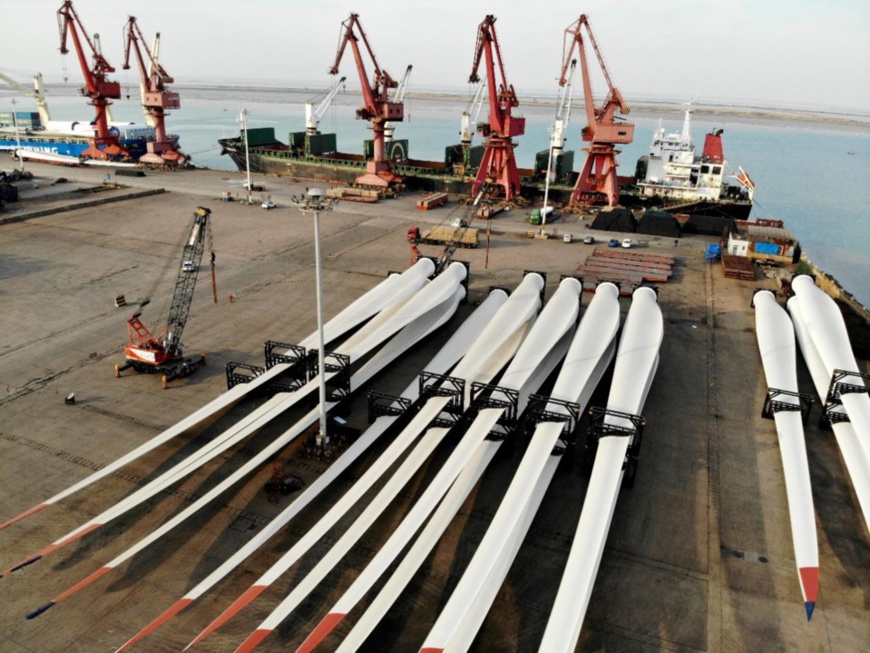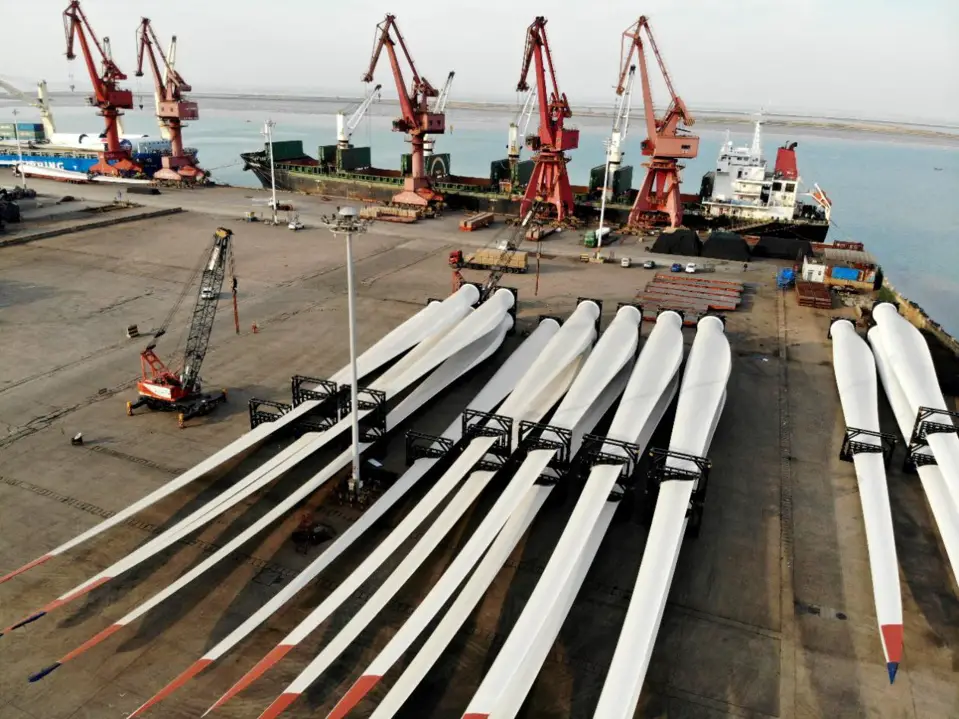By Yu Yichun, People’s Daily

Photo shows wind power equipment to be shipped to Chile at the Lianyungang Port in Lianyungang city, east China’s Jiangsu province through the Maritime Silk Road in November. (Photo by Wang Chun/People’s Daily Online)
In recent years, projects of cooperation in environmental protection technologies and green industry have been implemented in the joint pursuit of the Belt and Road Initiative (BRI).
To build a green Belt and Road, China has worked with relevant countries to enhance cooperation in conserving the environment, protecting biodiversity and tackling climate change, launch green infrastructure projects, make green investment and provide green financing.
According to data released by the American Enterprise Institute for Public Policy Research, in the first half of 2020, the share of renewable energy investments was higher than that of fossil fuel energy investments in Belt and Road projects.
Fabiano Faria is a manager of the second phase of the Belo Monte 800KV ultra-high voltage (UHV) direct current transmission project in Brazil.
Boarding a helicopter with his binoculars and digital camera, Faria and his colleagues flew a total of 67 hours in 12 days to inspect the 2,500-kilometer transmission line built by the State Grid Corporation of China.
The line transmits clean electricity from the Amazon Basin in northern Brazil to the populous south, crossing dense forests, vast plantations and rolling mountains.
During the construction of the project, the Chinese company employed over 600 plant and animal experts for the environmental protection work to minimize the impact of the project on the environment, Faria said.
“The iron towers are tall so as not to hurt the trees. Moreover, the experts also did a good job in restoring the environment such as soil stabilization and reforestation,” he introduced.
Since it started operation one year ago, the longest 800kV UHV transmission line in the world has met the electricity needs of about 22 million people, playing a vital role in promoting Brazil’s economic growth and the pursuit of green energy.
On the reddish-brown hills of the Great Karoo Plateau in southern South Africa, white wind turbines operate slowly to generate electricity that can meet the needs of the nearby De Aar.
As the largest wind power project in South Africa, it generates about 760 million kWh of green power for the area each year, saving 215,800 tons of standard coal and reducing 619,900 tons of carbon dioxide emissions each year. It is expected to meet the electricity demand of 300,000 local households.
Senior South African diplomat Gert Grobler pointed out that South Africa, a major electricity producing nation in Africa, generates 40 percent of all electricity on the continent, but over 90 percent of the country’s electricity is produced from coal.
The new energy project undertaken by a Chinese company is changing the energy structure of South Africa, the diplomat said, adding that the project also conforms to the country’s national plan of reducing its dependence on thermal power and developing clean energy, thus making important contributions to promoting green development in Africa.
In Britain, the largest energy storage project in Europe developed by China Huaneng Group Co., Ltd.—the British Mendi Battery Energy Storage Project began cold state commissioning on Aug. 25. This marked the project’s entry into the final stage of development and it is scheduled to be put into commercial operation by the end of the year.
Britain has witnessed rapid development of renewable energy, but it still faces the intermittent and volatility of power output. After its completion, the Mendi battery energy storage project will mainly participate in peak shaving and frequency modulation, fast frequency response, black start, capacity market and other services of the British power market.
The project can also provide emergency support power supply in the event of an accident in the country’s major power grid and improve the safety and stability of power system operation.
The European Union (EU) and China enjoy great cooperation potential in specific emission reduction targets and post-epidemic economic recovery, and even in accelerating the transition to a greener global economy, said Lutz Weischer, head of International Climate Policy at Germany’s environmental organization Germanwatch.
China is vigorously advancing ecological progress, and EU-China green cooperation will lead the world’s green cooperation and development, Weischer noted.
“By advocating green development, Belt and Road projects have promoted sustainable local production practices,” said Marcos Freitas, head of the International Virtual Institute for Global Change under the Federal University of Rio de Janeiro in Brazil.
Freitas added that China has actively advocated the concept of eco-friendly development in the joint pursuit of the BRI, and the building of a green Silk Road has become an important measure to implement the United Nations’ 2030 Agenda for Sustainable Development and gained broad support.
To build a green Belt and Road, China has worked with relevant countries to enhance cooperation in conserving the environment, protecting biodiversity and tackling climate change, launch green infrastructure projects, make green investment and provide green financing.
According to data released by the American Enterprise Institute for Public Policy Research, in the first half of 2020, the share of renewable energy investments was higher than that of fossil fuel energy investments in Belt and Road projects.
Fabiano Faria is a manager of the second phase of the Belo Monte 800KV ultra-high voltage (UHV) direct current transmission project in Brazil.
Boarding a helicopter with his binoculars and digital camera, Faria and his colleagues flew a total of 67 hours in 12 days to inspect the 2,500-kilometer transmission line built by the State Grid Corporation of China.
The line transmits clean electricity from the Amazon Basin in northern Brazil to the populous south, crossing dense forests, vast plantations and rolling mountains.
During the construction of the project, the Chinese company employed over 600 plant and animal experts for the environmental protection work to minimize the impact of the project on the environment, Faria said.
“The iron towers are tall so as not to hurt the trees. Moreover, the experts also did a good job in restoring the environment such as soil stabilization and reforestation,” he introduced.
Since it started operation one year ago, the longest 800kV UHV transmission line in the world has met the electricity needs of about 22 million people, playing a vital role in promoting Brazil’s economic growth and the pursuit of green energy.
On the reddish-brown hills of the Great Karoo Plateau in southern South Africa, white wind turbines operate slowly to generate electricity that can meet the needs of the nearby De Aar.
As the largest wind power project in South Africa, it generates about 760 million kWh of green power for the area each year, saving 215,800 tons of standard coal and reducing 619,900 tons of carbon dioxide emissions each year. It is expected to meet the electricity demand of 300,000 local households.
Senior South African diplomat Gert Grobler pointed out that South Africa, a major electricity producing nation in Africa, generates 40 percent of all electricity on the continent, but over 90 percent of the country’s electricity is produced from coal.
The new energy project undertaken by a Chinese company is changing the energy structure of South Africa, the diplomat said, adding that the project also conforms to the country’s national plan of reducing its dependence on thermal power and developing clean energy, thus making important contributions to promoting green development in Africa.
In Britain, the largest energy storage project in Europe developed by China Huaneng Group Co., Ltd.—the British Mendi Battery Energy Storage Project began cold state commissioning on Aug. 25. This marked the project’s entry into the final stage of development and it is scheduled to be put into commercial operation by the end of the year.
Britain has witnessed rapid development of renewable energy, but it still faces the intermittent and volatility of power output. After its completion, the Mendi battery energy storage project will mainly participate in peak shaving and frequency modulation, fast frequency response, black start, capacity market and other services of the British power market.
The project can also provide emergency support power supply in the event of an accident in the country’s major power grid and improve the safety and stability of power system operation.
The European Union (EU) and China enjoy great cooperation potential in specific emission reduction targets and post-epidemic economic recovery, and even in accelerating the transition to a greener global economy, said Lutz Weischer, head of International Climate Policy at Germany’s environmental organization Germanwatch.
China is vigorously advancing ecological progress, and EU-China green cooperation will lead the world’s green cooperation and development, Weischer noted.
“By advocating green development, Belt and Road projects have promoted sustainable local production practices,” said Marcos Freitas, head of the International Virtual Institute for Global Change under the Federal University of Rio de Janeiro in Brazil.
Freitas added that China has actively advocated the concept of eco-friendly development in the joint pursuit of the BRI, and the building of a green Silk Road has become an important measure to implement the United Nations’ 2030 Agenda for Sustainable Development and gained broad support.
 Menu
Menu
 Work together to promote green Belt and Road
Work together to promote green Belt and Road
















